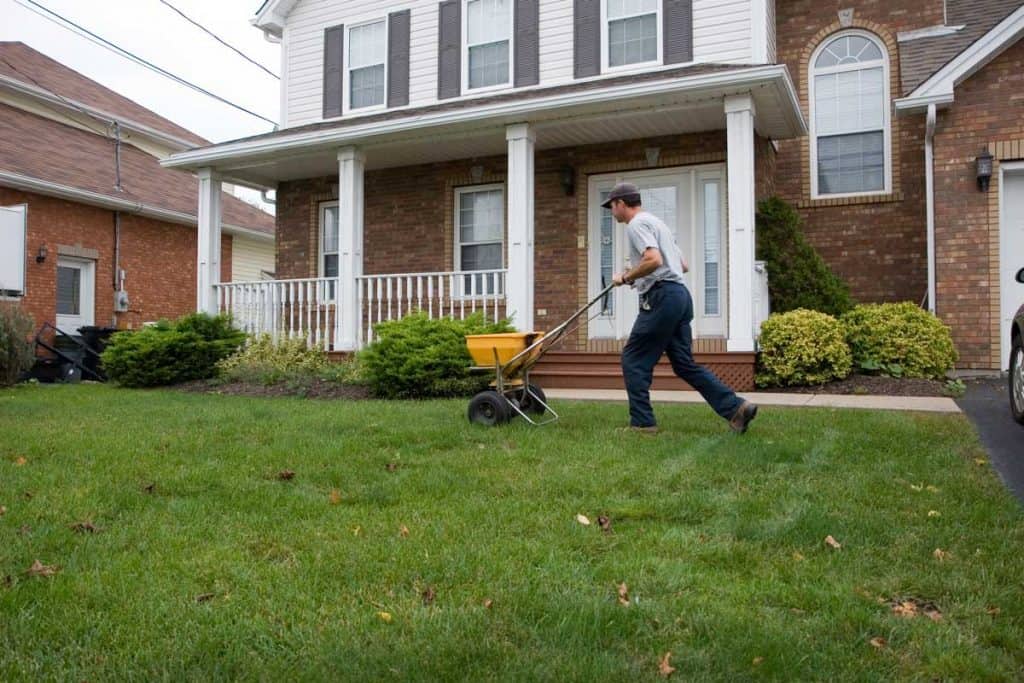 A thick, lush bed of dark green grass boosts the curb appeal of any home. Sun, water, and fertilizer are the keys to a healthy lawn. But is it possible to have too much of a good thing when it comes to lawn care? Can you over-fertilize a lawn? We researched this to help you have the beautiful yard of your dreams!
A thick, lush bed of dark green grass boosts the curb appeal of any home. Sun, water, and fertilizer are the keys to a healthy lawn. But is it possible to have too much of a good thing when it comes to lawn care? Can you over-fertilize a lawn? We researched this to help you have the beautiful yard of your dreams!
Yes, you can over-fertilize a lawn. If you notice yellow or brown grass the day after application, you have overdone it on the fertilizer. This is often referred to as ‘fertilizer burn’ and results in dead or damaged grass caused by excessive levels of salt and nitrogen in the soil.
Now that you know it’s possible to over-fertilize your lawn let’s take a closer look at this in more detail below. We’ll discuss the signs of over-fertilizing as well as why too much fertilizer will not only damage but ultimately kill your grass. We’ll also explore ways to regrow burnt-out grass and regain a healthy lawn.
So, if you’re ready to learn more about fertilizer and proper lawn care, then let’s get started!
What are Signs of Over Fertilizing?
There are five signs that you have over fertilized your lawn. These include the following:
- yellow or brown grass blades or tips
- limp, black grass roots
- patchy lawn appearance - areas of green grass mixed with yellow or brown grass
- very slow regrowth after fertilizing
- little to no regrowth after fertilizing
What are the Ways You Can Over Fertilize Your Lawn?
Over-fertilizing your lawn is often the result of the following:
- not following the fertilizing instructions properly
- dumping too much fertilizer in one spot too quickly
- accidentally spilling the fertilizer
- soil that doesn’t drain well causing a buildup of fertilizer
- not watering your lawn enough after fertilizing
How to Correct Over-Fertilizing
When you damage or destroy your lawn with too much fertilizer, you must find ways to leach out the excess product from the ground before reseeding it. The best way to do this includes the following five steps:
- Water your lawn – for your lawn to recover, you must wash away the extra fertilizer first. Turn on your sprinklers and saturate the grass with water. Apply at least one inch of water every day for a full week. Then, give your lawn three days to dry out before reseeding.
- Add new topsoil – fill in the dead or damaged patches of lawn with topsoil and then gently tamp it down. Apply enough topsoil so that it completely covers the surface area. Smooth over it with a rake and then prepare the seed mixture.
- Sprinkle grass seed – begin by combining one-part grass seed with three-parts topsoil. Spread the mixture over the pre-prepared ground. Ensure that the coverage is even and then top off the area with a thin layer of compost.
- Water the seeded area – be sure to water the area immediately after seeding. Give it a good soak at least once a day for the first week until you start to see seeds germinating. Be careful not to overwater the area as you want the soil to be moist, not soggy.
- Fertilize the seedlings – when you notice two-thirds of the seedlings growing, fertilize the area with a nitrogen, phosphorus, potassium fertilizer in a 5-10-5 formulation. Use sparingly (approximately two teaspoons per square foot) and water the area thoroughly once again.
Can Over Fertilizing Kill Grass?

As already mentioned above, over-fertilizing can indeed kill your lawn. Increased nitrogen and salt levels in the soil will result in damaged or dead grass. When this happens, it’s often referred to as ‘fertilizer burn’ whereby sections of lawn appear yellow or brown and grow very slowly, if at all.
How to Avoid Over Fertilizing
The best way to ensure that you don’t over-fertilize your lawn is to follow the five steps listed below:
- Begin by watering your lawn thoroughly a few days before applying fertilizer. Make sure to give it a good soaking. This will help guarantee that the soil is moist and ready for feeding.
- Chose the appropriate fertilizer and spreader to meet your specific lawn care needs. Be sure to adjust the spreader positions correctly, as each fertilizing product has its unique setting for proper coverage. NEVER spread product by hand, and ALWAYS follow the manufacturer’s suggested guidelines.
- Read the instructions carefully and apply fertilizer around the perimeter of the lawn first. This will ensure that you don’t miss any outside edges of the grass. Be careful to avoid getting fertilizer in garden beds, near sideways, or on driveways whenever possible.
- Apply fertilizer to the middle of the lawn, going back and forth across all areas in a straight line, similar to that of a mowing pattern. Slightly overlap with each pass, taking caution not to lay too much product.
- Return any unused fertilizer to the bag and store it in a cool, dry place for future use. Properly handling of the product is critical, so use safety gloves and keep it away from children and pets.
How Do I Know if My Lawn Needs Nitrogen?
Excessive weed growth is often an indication that your lawn is lacking in nitrogen. A reduced number of grass clippings than usual after mowing can also be a sign of nitrogen depletion. The most common symptoms, however, are yellow or yellow-green grass blades, little to no regrowth, and a low grass density. Although seasonal changes may sometimes be the culprit, more likely than not, it’s a nitrogen deficiency, and therefore fertilizer is required.
Can You Put Too Much Nitrogen on Your Lawn?
There is the possibility that you could put too much nitrogen on your lawn when fertilizing. If you accidentally spill fertilizer on your lawn or spread too much in one specific area, you run the risk of burning out your grass due to too much nitrogen in the soil. If you notice yellow or brown patches of grass that grow slowly or not at all after fertilizing, then you’ve likely (albeit unwittingly) overdone it!
Slow-release fertilizers help reduce the risk of nitrogen burn out. They provide for better growth overall with a more uniform appearance. They also remain in the soil for six to eight weeks (sometimes longer), so you don’t need to use them as often as quick release fertilizers - which can not only burn out your lawn if over-applied but also destroy surrounding plants.
Will Grass Grow Back After Being Burned?
There is still hope for a lawn that has been damaged or destroyed due to over-fertilizing.
Start by physically removing any fertilizer that has built up on top of the soil! Next, water your lawn until it’s thoroughly drenched. This will help flush out the excess salt and nitrogen deposits, assisting the roots to recover faster.
Continue to water your lawn every day for a week, preferably in the morning, to prevent fungus from developing. This will also get any lingering fertilizer out of the soil so your grass can start to grow healthy once again. If you choose to reapply fertilizer at a later date, always follow the instructions provided by the manufacturers to a ‘T’ for best results.
Summation
To summarize, you can indeed over-fertilize your lawn. Yellow or brown grass the day after the application is usually a sign of fertilizer burn out. Dead or damaged grass caused by increased levels of nitrogen and salt is often the result. There are ways, however, to regain a healthy lawn, so don’t despair. Check out our post on how to aerate your lawn here. That lush, bed of thick, green grass can once again be yours if you read the information carefully and follow the suggestions presented in this article.

Thanks for explaining that a yellow color is the most common indication that our lawn is in need of nitrogen. My husband and I are considering hiring a lawn fertilization service since we just moved to a home with a large yard and neither of us has the time in our schedules to care for it ourselves. Asking about nitrogen should help us find a knowledgeable lawn service to hire, so thanks for sharing this article and giving me the idea!